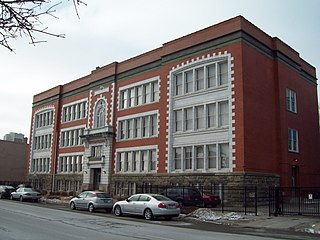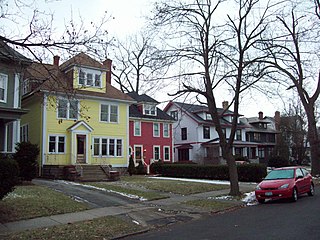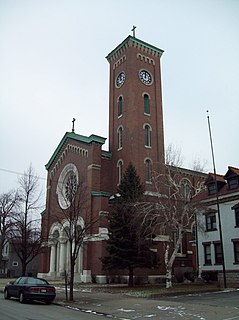
The Allentown district is a neighborhood in Buffalo, New York. The neighborhood is home to the Allentown Historic District.

Orchard Park station is a historic railway station located at Orchard Park in Erie County, New York. It was constructed in 1911 and served passenger trains until the 1950s.

Trinity Episcopal Church is a historic Episcopal church complex located at Buffalo in Erie County, New York. The oldest part of the complex was built in 1869 as the Gothic Revival style Christ Chapel; it was later redesigned in 1913. The main church was constructed in 1884–1886 in the Victorian Gothic style and features stained glass windows designed by John LaFarge and Tiffany studios. The parish house, designed by Cram, Goodhue & Ferguson, was constructed in 1905.

James and Fanny How House is a historic home located at Buffalo in Erie County, New York. It is a noted example of a Tudor Revival–style dwelling designed by local architect Harold L. Olmsted in 1924. It is composed of three sections: a 2+1⁄2-story cross-gabled front block, a 1-story gabled connecting link, and a 2-story gabled rear block with a small 1-story wing. It has a limestone ashlar and concrete foundation and painted stucco-covered exterior walls of brick and tile.

Edwin M. and Emily S. Johnston House is a historic home located at Buffalo in Erie County, New York. It is a Colonial Revival style brick dwelling designed by Bley & Lyman in 1934. It consists of a 2+1⁄2-story cross-gabled main block with a 2-story side-gabled garage wing.

School 13, also known as Boys Vocational High School and Buffalo Alternative High School, is a historic school building located at Buffalo in Erie County, New York. It was built about 1915, and is a three-story, steel framed building sheathed in brick and terra cotta with Beaux-Arts style design elements. The "T"-shaped building housed administrative offices, classrooms, a gymnasium, swimming pool, and two-story auditorium. The building housed a school until 2003.

Rev. J. Edward Nash Sr. House is a historic home located at Buffalo in Erie County, New York. The house was constructed in 1892 and is in the Queen Anne style. It was home to Rev. J. Edward Nash Sr. (1868–1957), a prominent leader in Buffalo's African American community. He served as pastor at the Michigan Avenue Baptist Church from 1892 to 1953. Rev. Nash purchased the frame, two flat home in 1925 and his wife remained in the home until 1987. The house underwent exterior restoration in 2002-2003 and has been designated the Nash House Museum.

Engine House No. 28 is a historic fire station building located at Buffalo in Erie County, New York. It is a Queen Anne style structure built in 1897.

George and Gladys Scheidemantel House is a historic home located at East Aurora in Erie County, New York. It is a locally distinctive example of the Arts and Crafts movement style of architecture built in 1910. It is a two-story, frame, bungalow that combines elements of the American Foursquare and Craftsman styles. George Scheidemantel was for a time head of the Roycroft Leather Shop and the house designer, William Roth, was head Roycroft carpenter.

Villa Maria Motherhouse Complex, or Felician Sisters Immaculate Heart of Mary Convent Chapel and Convent, is a historic Roman Catholic convent and school complex located at Cheektowaga in Erie County, New York. It is included in the Roman Catholic Diocese of Buffalo. It was constructed in 1927, and is a three-part Gothic Revival building that was built for the Felician Sisters of St. Francis to house a boarding and day high school, public and private chapels and the Motherhouse/Novitiate. The school, known as Villa Maria Academy, closed in 2002.

Parkside East Historic District is a national historic district located at Buffalo in Erie County, New York. The district is architecturally and historically significant for its association with the 1876 Parks and Parkways Plan for the city of Buffalo developed by Frederick Law Olmsted. It consists of 1,769 contributing structures developed from 1876 to 1936, as a middle class residential neighborhood. The district largely contains single-family dwellings, built in a variety of popular architectural styles, and located along the irregular and curvilinear street pattern developed by Olmsted. The district is located to the east of Buffalo's Delaware Park and includes the Walter V. Davidson House and the separately listed Darwin D. Martin House, both designed by Frank Lloyd Wright.

South Buffalo North Side Light is a lighthouse formerly located at the entrance to Buffalo Harbor, Buffalo, New York. It is one of two "bottle shaped" beacons located in Buffalo Harbor; the other is the Buffalo North Breakwater South End Light. It is a 29-foot (8.8 m) high beacon constructed of boiler plate. It measures 10 feet 3⁄4 inch (3.067 m) at the bottom and 2 feet 3 inches (0.69 m) at the top. It is distinguished by four cast iron port windows and a curved iron door. It was first lit on September 1, 1903, and originally equipped with a 6th-order Fresnel lens. A battery operated 12 volt lamp with a 12-inch (300 mm) green plastic lens was installed in the beacon c. 1960, when a domed roof formerly mounted over the lens was removed. The beacon was removed in 1985, and now stands at the gate to the Dunkirk Lighthouse and Veterans Park Museum. Its twin is located on the grounds of the Buffalo (main) Light.

Buffalo North Breakwater South End Light is a lighthouse formerly located at the entrance to Buffalo Harbor, Buffalo, New York. It is one of two "bottle shaped" beacons located in Buffalo Harbor; the other is the South Buffalo North Side Light. It is a 29-foot (8.8 m) high beacon constructed of boiler plate. It measures 10 feet 3⁄4 inch (3.067 m) at the bottom and 2 feet 3 inches (0.69 m) at the top. It is distinguished by four cast iron port windows and a curved iron door. It was first lit on September 1, 1903, and originally equipped with a 6th-order Fresnel lens. A battery operated 12 volt lamp with a 12 inches (300 mm) green plastic lens was installed in the beacon c. 1960, when a domed roof formerly mounted over the lens was removed. The beacon was removed in 1985, and now stands on the grounds of the Buffalo (main) Light. Its twin is located at the Dunkirk Lighthouse and Veterans Park Museum.

St. Francis Xavier Roman Catholic Parish Complex is a historic former Roman Catholic church complex located in Buffalo in Erie County, New York.

Engine House No. 2 and Hook and Ladder No. 9, also known as Jersey Street Firehouse, is a historic fire station located at Buffalo in Erie County, New York.

The Dayton House is a historic home located at 243 Dearborn Street, in the Black Rock neighborhood of Buffalo, Erie County, New York.

House at 218 Dearborn Street is a historic home located in the Black Rock neighborhood of Buffalo in Erie County, New York. It was built about 1880, and is a one-story, wood-frame shotgun-style workers cottage on a limestone foundation. It is three bays wide and has a low pitched gable roof. It features a hipped roof front porch with decorative spandrels, added about 1890. Also on the property is a shed dated to about 1890.

Robert T. Coles House and Studio is a historic home and architectural design studio located at Buffalo in Erie County, New York. It was designed and built in 1961, by locally prominent African American architect Robert T. Coles. It consists of two prefabricated rectangular units arranged in an "L"-shape in the Modern style. The studio unit is a single story and living unit is two levels. It has post-and-beam construction with a variety of pre-fabricated, non-structural panels and sliding glass door units. Coles once worked for the Techbuilt company under Carl Koch and the design of this dwelling reflects that experience.
Esenwein & Johnnson was an architectural firm of Buffalo, New York.

Elmwood Historic District–East is a national historic district located at Buffalo, Erie County, New York. The district encompasses 2,405 contributing buildings, 31 contributing structures, and 14 contributing objects in the Elmwood Village neighborhood of Buffalo. It is bounded on the north by Delaware Park, Forest Lawn Cemetery, and the former Buffalo State Asylum, on the south by the Allentown Historic District, and on the west by the Elmwood Historic District–West. This predominantly residential district developed between about 1867 and 1965, and includes notable examples of Queen Anne, Shingle Style, Colonial Revival, Tudor Revival, and American Craftsman style architecture. The district contains one of the most intact collections of built resources from turn of the 20th century in the city of Buffalo and western New York State. Located in the district are 17 previously listed contributing resources including the Buffalo Seminary, Garret Club, James and Fanny How House, Edgar W. Howell House, Edwin M. and Emily S. Johnston House, Col. William Kelly House, Lafayette Avenue Presbyterian Church, Parke Apartments, and the Unitarian Universalist Church of Buffalo. Other notable building include the Frank Lloyd Wright designed William R. Heath House (1904-1905), Herbert H. Hewitt House, School 56 (1910-1911), the Harlow House, A. Conger Goodyear house, Alexander Main Curtiss House, Nardin Academy campus, and Coatsworth House (1897).























